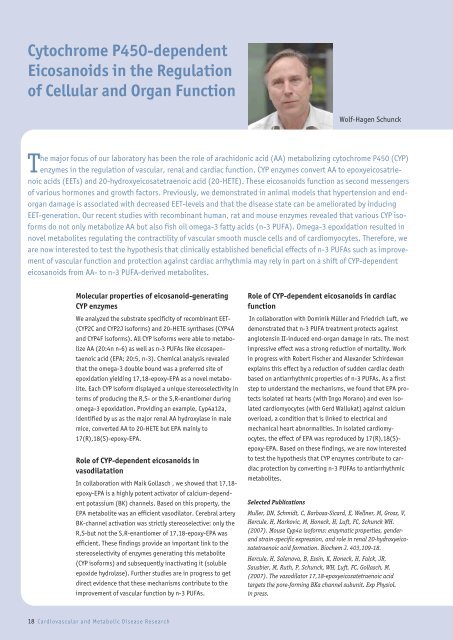of the Max - MDC
of the Max - MDC
of the Max - MDC
Create successful ePaper yourself
Turn your PDF publications into a flip-book with our unique Google optimized e-Paper software.
Cytochrome P450-dependent<br />
Eicosanoids in <strong>the</strong> Regulation<br />
<strong>of</strong> Cellular and Organ Function<br />
Wolf-Hagen Schunck<br />
The major focus <strong>of</strong> our laboratory has been <strong>the</strong> role <strong>of</strong> arachidonic acid (AA) metabolizing cytochrome P450 (CYP)<br />
enzymes in <strong>the</strong> regulation <strong>of</strong> vascular, renal and cardiac function. CYP enzymes convert AA to epoxyeicosatrienoic<br />
acids (EETs) and 20-hydroxyeicosatetraenoic acid (20-HETE). These eicosanoids function as second messengers<br />
<strong>of</strong> various hormones and growth factors. Previously, we demonstrated in animal models that hypertension and endorgan<br />
damage is associated with decreased EET-levels and that <strong>the</strong> disease state can be ameliorated by inducing<br />
EET-generation. Our recent studies with recombinant human, rat and mouse enzymes revealed that various CYP is<strong>of</strong>orms<br />
do not only metabolize AA but also fish oil omega-3 fatty acids (n-3 PUFA). Omega-3 epoxidation resulted in<br />
novel metabolites regulating <strong>the</strong> contractility <strong>of</strong> vascular smooth muscle cells and <strong>of</strong> cardiomyocytes. Therefore, we<br />
are now interested to test <strong>the</strong> hypo<strong>the</strong>sis that clinically established beneficial effects <strong>of</strong> n-3 PUFAs such as improvement<br />
<strong>of</strong> vascular function and protection against cardiac arrhythmia may rely in part on a shift <strong>of</strong> CYP-dependent<br />
eicosanoids from AA- to n-3 PUFA-derived metabolites.<br />
Molecular properties <strong>of</strong> eicosanoid-generating<br />
CYP enzymes<br />
We analyzed <strong>the</strong> substrate specificity <strong>of</strong> recombinant EET-<br />
(CYP2C and CYP2J is<strong>of</strong>orms) and 20-HETE synthases (CYP4A<br />
and CYP4F is<strong>of</strong>orms). All CYP is<strong>of</strong>orms were able to metabolize<br />
AA (20:4n n-6) as well as n-3 PUFAs like eicosapentaenoic<br />
acid (EPA; 20:5, n-3). Chemical analysis revealed<br />
that <strong>the</strong> omega-3 double bound was a preferred site <strong>of</strong><br />
epoxidation yielding 17,18-epoxy-EPA as a novel metabolite.<br />
Each CYP is<strong>of</strong>orm displayed a unique stereoselectivity in<br />
terms <strong>of</strong> producing <strong>the</strong> R,S- or <strong>the</strong> S,R-enantiomer during<br />
omega-3 epoxidation. Providing an example, Cyp4a12a,<br />
identified by us as <strong>the</strong> major renal AA hydroxylase in male<br />
mice, converted AA to 20-HETE but EPA mainly to<br />
17(R),18(S)-epoxy-EPA.<br />
Role <strong>of</strong> CYP-dependent eicosanoids in<br />
vasodilatation<br />
In collaboration with Maik Gollasch , we showed that 17,18-<br />
epoxy-EPA is a highly potent activator <strong>of</strong> calcium-dependent<br />
potassium (BK) channels. Based on this property, <strong>the</strong><br />
EPA metabolite was an efficient vasodilator. Cerebral artery<br />
BK-channel activation was strictly stereoselective: only <strong>the</strong><br />
R,S-but not <strong>the</strong> S,R-enantiomer <strong>of</strong> 17,18-epoxy-EPA was<br />
efficient. These findings provide an important link to <strong>the</strong><br />
stereoselectivity <strong>of</strong> enzymes generating this metabolite<br />
(CYP is<strong>of</strong>orms) and subsequently inactivating it (soluble<br />
epoxide hydrolase). Fur<strong>the</strong>r studies are in progress to get<br />
direct evidence that <strong>the</strong>se mechanisms contribute to <strong>the</strong><br />
improvement <strong>of</strong> vascular function by n-3 PUFAs.<br />
Role <strong>of</strong> CYP-dependent eicosanoids in cardiac<br />
function<br />
In collaboration with Dominik Müller and Friedrich Luft, we<br />
demonstrated that n-3 PUFA treatment protects against<br />
angiotensin II-induced end-organ damage in rats. The most<br />
impressive effect was a strong reduction <strong>of</strong> mortality. Work<br />
in progress with Robert Fischer and Alexander Schirdewan<br />
explains this effect by a reduction <strong>of</strong> sudden cardiac death<br />
based on antiarrhythmic properties <strong>of</strong> n-3 PUFAs. As a first<br />
step to understand <strong>the</strong> mechanisms, we found that EPA protects<br />
isolated rat hearts (with Ingo Morano) and even isolated<br />
cardiomyocytes (with Gerd Wallukat) against calcium<br />
overload, a condition that is linked to electrical and<br />
mechanical heart abnormalities. In isolated cardiomyocytes,<br />
<strong>the</strong> effect <strong>of</strong> EPA was reproduced by 17(R),18(S)-<br />
epoxy-EPA. Based on <strong>the</strong>se findings, we are now interested<br />
to test <strong>the</strong> hypo<strong>the</strong>sis that CYP enzymes contribute to cardiac<br />
protection by converting n-3 PUFAs to antiarrhythmic<br />
metabolites.<br />
Selected Publications<br />
Muller, DN, Schmidt, C, Barbosa-Sicard, E, Wellner, M, Gross, V,<br />
Hercule, H, Markovic, M, Honeck, H, Luft, FC, Schunck WH.<br />
(2007). Mouse Cyp4a is<strong>of</strong>orms: enzymatic properties, genderand<br />
strain-specific expression, and role in renal 20-hydroxyeicosatetraenoic<br />
acid formation. Biochem J. 403,109-18.<br />
Hercule, H, Salanova, B, Essin, K, Honeck, H, Falck, JR,<br />
Sausbier, M, Ruth, P, Schunck, WH, Luft, FC, Gollasch, M.<br />
(2007). The vasodilator 17,18-epoxyeicosatetraenoic acid<br />
targets <strong>the</strong> pore-forming BKa channel subunit. Exp Physiol.<br />
in press.<br />
18 Cardiovascular and Metabolic Disease Research
















